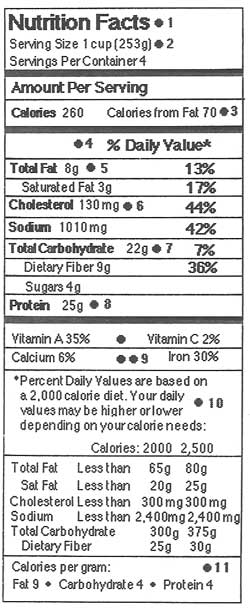I’ve taken a typical food label and “deconstructed” it to help you make healthy choices. Take a look at the following food label and then follow along with the numbered bullets below it to better understand what is in the food you’re eating and how your food choices, based on their labels, meet your daily dietary goals.
Food Label Breakdown

- Nutrition facts tells the consumer that the FDA has approved the label.
- The serving size represents all the quantities of nutrients listed on the label. If you’re consuming 2 cups of this particular food, there will be 16 grams of fat. The grams in parenthesis indicate how much the serving size weighs.
- Calories from fat are usually rounded off. By multiplying the total fat (in this case, 8 grams) by the number of calories in each gram of fat (9 calories) the result will be the total calories from fat. 9 x 8 = 72 calories from fat. This number was rounded down to 70.
- % Daily Value is explained near the (*) asterisk. It is based on a 2,000 calorie diet. This may not be suitable for everyone – it may be too high or too low. On a 2,000 calorie diet, your total fat intake should be less than 65 grams. Therefore, the total fat of 8 grams listed is 13% of the total daily value of fat or 13% of 65 grams is eight grams.
- The total fat figure includes all fats: saturated, polyunsaturated and monounsaturated. These three fats should add up to the total. If they don’t the remainder can be from trans fat (only if there is partially hydrogenated oil in the ingredient list) or from a smaller amount of fat (.5 or 1/2 a gram) that is not required to be listed.
- Cholesterol should not exceed 300 mg per day. If you have heart disease, limit your cholesterol intake to 200 mg per day. The yolk of one egg has 215 mg of cholesterol. Eggs do, however, contain ample vitamins and minerals. Consume fewer than four a week if you have heart disease or diabetes.
- Total carbohydrate turns completely into sugar except for the dietary fiber part. In this case, nine grams of fiber may be subtracted from the total carbohydrate to find the amount of sugar this product will actually breakdown into. Only 13 grams of total carbohydrate will turn into sugar in your bloodstream within one to two hours. The four grams of sugar listed come from refined/processed sugar like high fructose corn syrup, molasses or honey or (natural sugar: milk (lactose) or fruit (fructose) found in this product. The number of grams of carbohydrates you would count is 13 grams, which would include the refined sugar while subtracting the non-digestible fiber.
- Protein is listed in grams. However, we think of protein in terms of ounces. Seven grams is equal to one ounce in terms of ounces. Seven grams is equal to one ounce of protein on the food label. In this case, there are 25 grams of protein. This is equal to approximately 3 1/2 ounces of protein.
- This product offers six percent of your total calcium allowance for the day.
- See #4.
- There are more than twice the calories in each gram of fat than in each gram of carbohydrate or protein.
Some additional food label reading how-to’s:
- All bolded words contain the categories underneath them. Total fat contains all types of fat indented and in lighter print underneath it whereas Total Carbohydrate contains dietary fiber and sugar.
- A low-fat food has three grams of fat or less per serving.
- A low-sodium food has 140 mg per serving or 400-600 mg per meal. Limit sodium consumption to 1,500 – 3,000 mg per day and at least 500 mg per day. If you are on a low-sodium diet due to hypertension or kidney disease consume fewer than 2,000 mg.
When looking at food labels, be sure to look at total carbohydrate, NOT SUGAR, when trying to determine what will breakdown into glucose in your bloodstream. The sugar listed is included in the total carbohydrate. It refers to natural sugar, like fruit sugar (fructose) or milk sugar (lactose) or refined/processed sugar like table sugar.
The total carbohydrate encompasses everything in that food that will eventually become sugar. Dietary fiber, however, may be subtracted from the total carbohydrate, since fiber is a non-digestible part of the carbohydrate.
Try one of Marci’s convenient diabetes-friendly “Calorie Diets” based on the daily calorie intake recommended by the FDA or your doctor.






Leave A Comment